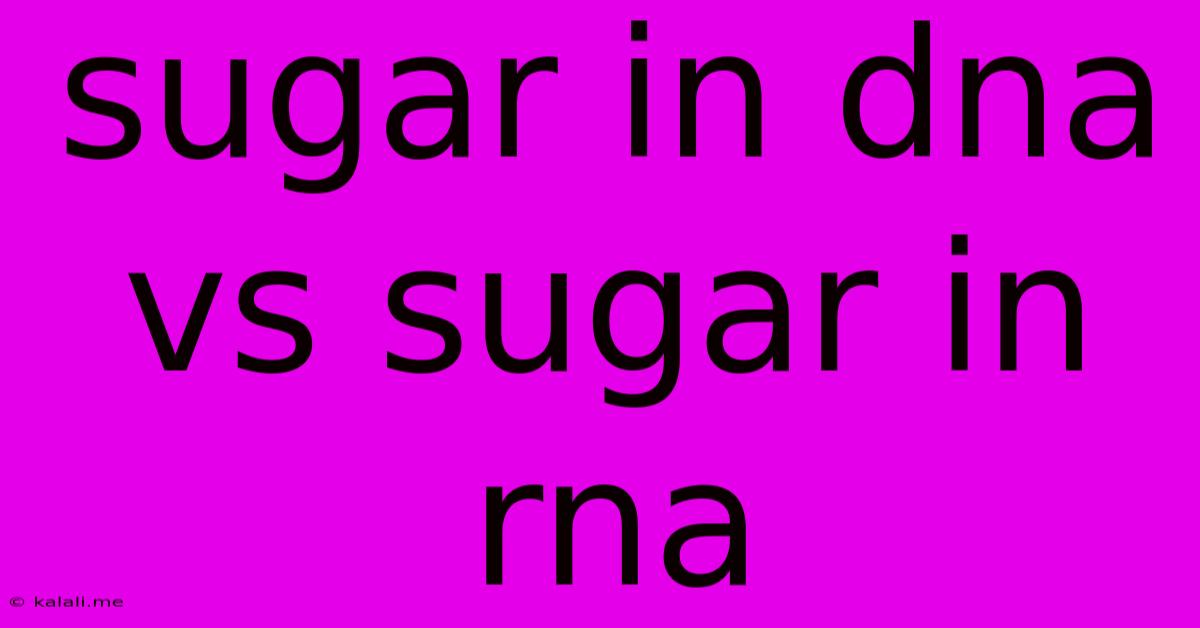Sugar In Dna Vs Sugar In Rna
Kalali
Jun 14, 2025 · 3 min read

Table of Contents
Sugar in DNA vs. Sugar in RNA: A Key Difference with Major Implications
Meta Description: Explore the crucial differences between DNA and RNA, focusing on their respective sugars: deoxyribose and ribose. Understand how this seemingly small difference impacts their structure, function, and stability.
Deoxyribonucleic acid (DNA) and ribonucleic acid (RNA) are both nucleic acids essential for life, carrying genetic information and facilitating protein synthesis. While they share many similarities, a key difference lies in the type of sugar molecule they contain: deoxyribose in DNA and ribose in RNA. This seemingly subtle distinction has profound consequences for their structure, function, and overall stability. Let's delve deeper into the specifics.
The Sugar Structure: Deoxyribose vs. Ribose
The core difference lies in the presence or absence of a hydroxyl (-OH) group at the 2' carbon atom of the sugar molecule. Ribose, the sugar in RNA, has a hydroxyl group at this position. Deoxyribose, found in DNA, lacks this hydroxyl group—hence the "deoxy" prefix. This seemingly small detail has significant impacts on the molecules' properties.
Impact on Molecular Structure and Stability
The absence of the 2'-hydroxyl group in deoxyribose contributes to DNA's greater stability compared to RNA. The hydroxyl group in ribose makes RNA more susceptible to hydrolysis, a chemical reaction where water breaks down the molecule. This increased susceptibility contributes to RNA's generally shorter lifespan compared to the much more stable DNA. The greater stability of DNA is crucial for its role in long-term storage of genetic information.
The presence of the hydroxyl group in ribose also influences RNA's secondary structure. It can participate in hydrogen bonding, allowing for more complex three-dimensional folding patterns. These folds are crucial for RNA's diverse functional roles beyond simply carrying genetic information, including acting as enzymes (ribozymes) and playing vital roles in gene regulation and protein synthesis.
Functional Implications
The differing sugar structures contribute to the distinct roles DNA and RNA play within the cell:
-
DNA: Primarily responsible for storing genetic information, acting as a blueprint for the organism. Its stability ensures the accurate transmission of genetic code across generations. The double helix structure, stabilized in part by the deoxyribose sugar, protects the genetic information from degradation.
-
RNA: Plays a diverse array of roles, including:
- mRNA (messenger RNA): Carries genetic information from DNA to the ribosomes for protein synthesis.
- tRNA (transfer RNA): Delivers amino acids to the ribosomes during translation.
- rRNA (ribosomal RNA): A structural component of ribosomes, crucial for protein synthesis.
- Regulatory RNA: Involved in gene expression regulation.
The inherent instability of RNA, influenced by its ribose sugar, might seem counterintuitive given its crucial roles. However, this instability is precisely what makes RNA suitable for its dynamic and transient functions in gene expression. Its relatively short lifespan allows for rapid responses to cellular changes and precise control over protein synthesis.
Conclusion: A Subtle Difference with Profound Consequences
The difference between the sugars in DNA and RNA—deoxyribose and ribose, respectively—is a seemingly minor chemical distinction. However, this difference has profound implications for their structures, stabilities, and ultimately their biological functions within the cell. Understanding this key distinction is fundamental to comprehending the complexities of molecular biology and the central dogma of molecular genetics. The stability of DNA ensures the safekeeping of genetic information, while the instability of RNA allows for its versatility in mediating gene expression. These contrasting properties highlight the elegant design of biological systems and the remarkable interplay between structure and function.
Latest Posts
Latest Posts
-
How To Find The Midpoint Of A Triangle
Jun 15, 2025
-
Which Of The Following Is An Example Of Punishment
Jun 15, 2025
-
Average Gpa For Iowa State University
Jun 15, 2025
-
Difference In Quantity Supplied And Supply
Jun 15, 2025
-
The Rate At Which Energy Is Transferred Is Called
Jun 15, 2025
Related Post
Thank you for visiting our website which covers about Sugar In Dna Vs Sugar In Rna . We hope the information provided has been useful to you. Feel free to contact us if you have any questions or need further assistance. See you next time and don't miss to bookmark.